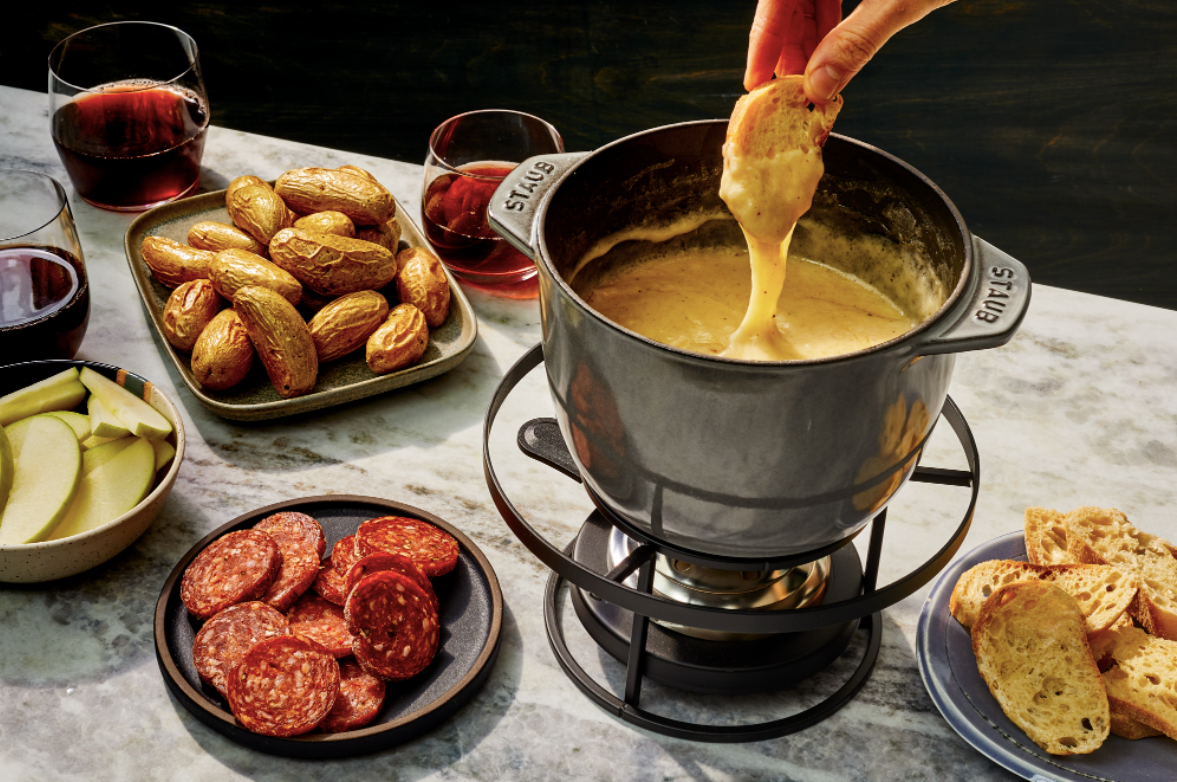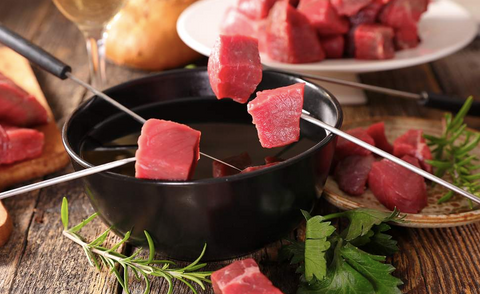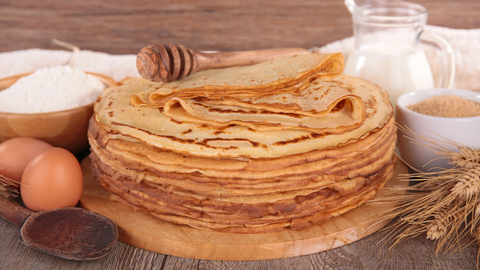What is Cheese Fondue?
Cheese fondue is a French, Swiss, and Italian dish of melted cheese in a communal pot (caquelon or fondue pot) over a portable stove (réchaud) heated with a candle or spirit lamp eaten by dipping bread into the cheese using long-stemmed forks.
"Fondue" comes from the French word for "melted." Fondue originated in Switzerland and is a delicious meal of melted cheese served in a communal pot (caquelon or fondue pot) over a portable stove (réchaud). About 1/2 inch cubed, bread cubes are dipped into the melted cheese using long-stemmed forks.
Today, with many other types of fondue, cheese fondue remains the most popular type of fondue. There are two main kinds of cheese fondue: one made with wine and one without wine, and Swiss cheese fondues tend to be made without wine, while French ones contain wine.
Cheese Fondue is so famous
Cheese fondue is not only famous for its taste but also its history. The process of melting cheese over the stove and adding bread to it was initially a way for peasants in Switzerland to use the bread and cheese they had. Later, this meal was served in fine-dining restaurants and was considered a delicacy. Today, cheese fondue with bread and vegetables is still famous in all parts of the world as an appetizer or a main course.
What goes with Cheese Fondue?
Fondue is a popular winter dish, but you can enjoy it any time of year. Classic cheese fondue is made with Emmentaler and Gruyère cheeses, but you can also make it with one type of cheese if that's all you have. Fondue is usually eaten as a snack or appetizer, but some people eat it for dinner — especially when paired with suitable side dishes. Here are some suggestions for side dishes to pair with cheese fondue:
- Salad
- Bread and crackers
- Roasted vegetables
- Cooked meats and seafood
- Potatoes
Cheese fondue is a traditional Swiss dish that's been around for centuries. The French word fondue comes from the past participle of the "fondre," which means "to melt."
Traditionally, cheese fondue is made with a combination of Gruyere and Emmental cheese, along with white wine, garlic, and nutmeg. It's served in a communal pot over the stove, and you dip chunks of bread or apples into it.
Nowadays, there are many variations both in the worldwide. So what goes with cheese fondue? Several different things! You can serve any food option which you like from salad, bread and crackers to roasted vegetables.
Dippers for Cheese Fondue
Some things are classic dippers for cheese fondue, while others may surprise you. Here are some ideas to get you started.
The most common dippers for cheese fondue are chunks of crusty bread. French bread or baguette is good choices, but any type will do as long as it's not soft or too sweet. Depending on your preference, you can leave the crust on or cut it off.
When choosing bread for your cheese fondue dipping, day-old (or older) bread works better than fresh because it has a crisp crust and won't fall.
Choosing Cheese for Fondue
Picking the right cheese for your fondue is essential. You want a cheese that will melt quickly and taste great when combined with wine and other ingredients.
Swiss cheeses like Emmental, Gruyère, or Appenzeller are good options for fondue because they have high-fat content and are relatively low in moisture. Other Alpine cheeses like Beaufort, Comté, or Tête de Moine also work well.
Taste is subjective, but I find that Swiss cheeses like Emmental, Gruyère, or Appenzeller make great fondues because they are high in fat and low in moisture. Other Alpine cheeses like Beaufort, Comté, or Tête de Moine also work well.
Mixing different Cheeses in Cheese Fondue
Cheese fondue is a great meal to serve at dinner parties, and it's simple, elegant, and surprisingly inexpensive. However, the quality of the cheese you use will make or break your fondue.
The key is to mix at least two different cheeses. A blend of cheeses will give you a combination of flavors and textures.
Some good choices for fondue include Gruyère, Emmentaler, and Appenzeller, which are all Swiss cheeses, though you can also find many imported versions. A mix of these three kinds of cheese is considered the classic choice, and it's hard to go wrong with them.
Other choices include Vacherin Fribourgeois, Beaufort and Comté from France; Manchego from Spain or a mix of Asiago, Fontina and Parmesan from Italy.
One thing to keep in mind about fondue is that the individual components should not be less than 60 percent cheese. So if you're adding wine, it shouldn't be more than 40 percent of the recipe, for example. You can also experiment with substituting beer for wine or even cider or some other flavored liquid to change up the flavor profile — make sure your cooking vessel can withstand boiling liquid (enameled cast).
What do you fall in Cheese Fondue?
The short answer is: It depends.
The bread is the classic option if you're making a basic cheese fondue, which is nothing more than melted cheese and wine. But if you're using a flavorful broth or adding other ingredients, then you can dip almost anything in it.
- Broth: Broth fondues are typically made with white wine or champagne. They don't contain any cheese and are often flavored with herbs such as rosemary, thyme, and garlic to complement the flavor of the meat used.
- Oil: Unlike broth fondues, oil fondues cook meat and seafood at a high temperature (350-400 degrees F). Classic oil fondues use peanut or vegetable oil, but olive oil works well. Oil fondues are flavored with garlic and herbs like parsley and thyme.
Cheese fondue consists of a melted cheese mixture served in a communal pot over a portable stove heated with a candle or spirit lamp, warmed to the table, and eaten by dipping bread into the cheese using long-stemmed forks.
Cheese can be mixed with other ingredients such as herbs or fruit, but traditionally it's just plain melted cheese and wine diluted with kirsch (cherry).

Is Cheese Fondue healthy option?
Cheese fondue is seen as a treat, not healthy food. But according to dietitians, there are health benefits to eating it, especially if you make it at home. Cheese fondue is made with cheese and wine, containing nutrients that promote good health.
While cheese fondue isn't an everyday meal, it may have surprising health benefits.
- Fondue is often associated with cold weather and holidays, but the dish may offer more than seasonal fun.
- In its most common form, cheese fondue is grated cheese mixed with wine, garlic, and seasonings like nutmeg and kirsch (a cherry-flavored brandy). Bread, vegetables, or fruit are dipped in the gooey mixture.
- According to dietitians, cheese fondue contains nutrients that promote good health, such as protein and calcium. Cheese also contains vitamin D and B vitamins.
Key to keeping your Cheese Fondue healthy
Make it yourself! When you make your fondue at home using quality ingredients, you can control the sodium content and limit artificial flavors by using whole foods like fresh vegetables or fruit for dipping.
Can Cheese Fondue be frozen?
Yes, it can. Here is how to freeze and thaw cheese fondue:
Freezing:
Make the cheese fondue, but do not add the kirsch. Let it cool, and then transfer to a freezer-safe container, leaving space for expansion at the top. You can use a large mason jar or heavy-duty freezer bags.
Thawing:
Place the frozen fondue in the fridge overnight to thaw. If you are in a hurry, you can set it in a bowl of hot water until it has melted. Once softened, stir in the kirsch (if desired) and heat over low heat, often stirring to prevent scorching until hot all the way through.
Reheating the Cheese Fondue
Cheese fondue can be reheated. As we know that melted cheese is generally not an excellent leftover candidate because it tends to separate and become oily when reheated. Fondue is more likely to hold together than other melted cheese dishes because the recipe's cornstarch helps keep the cheese from separating.
If you have leftover fondue, transfer it to a microwave-safe container and put it in the refrigerator. Before you reheat it, stir in 1 tablespoon (15 ml) of dry white wine or dry sherry per cup of fondue.
Then heat at 50 percent power for 2 minutes, stir, and continue heating at 10 percent power until the mixture is warm throughout. If your microwave doesn't have a 10 percent power setting, use 5 or 1 percent power. You can also reheat fondue in a saucepan over low heat, stirring frequently.
It is possible to use this method with other melted cheese recipes if they contain cornstarch and wine or another acidic ingredient such as lemon juice.
Cheese Fondue in the UK
The popularity of cheese fondue in the UK has risen since the 1950s. It seems that fondue is becoming one of the great British classics, with people eating it all year round and its popularity is increasing day by day.
In winter, it's a great way to keep warm, and in its many forms, it makes an excellent party dish. The traditional method is to dip bread into melted cheese, but these days you can also try dipping vegetables and even fruit into a variety of cheeses.
Bread for Cheese Fondue
When selecting bread for cheese fondue, your best choice is airy, crusty bread with no strong flavor that can easily be torn into bite-size pieces. A mild-flavored sourdough or baguette will work well. You can also use a loaf of dense rye bread, but you may want to cube it instead of tearing it into chunks.
- Baguettes are the traditional choice for dipping in fondue because they have a mild flavor and crisp crust that's perfect for dipping in creamy, melted cheese.
- The crust also helps to soak up some of the butter without becoming soggy quickly and the large "holes" inside provide more surface area for the cheese to cling to. I always try to buy fresh baguettes from my local bakery rather than one from the grocery store because those tend to be denser and less flavorful.
You can also use any other mild or slightly sweet bread that will hold up well when dipped in warm liquid. For example, you can use a good quality white sandwich bread or whole wheat bread but avoid very soft white sandwich bread (such as Wonder Bread).
I would not recommend using very dense or flavorful bread like pumpernickel or marble rye as your only dip
Wine pairings with Cheese Fondue
It is no secret that wine and cheese go together well, and each enhances the other, and many of the best pairings in the world feature these two classic ingredients.
What about when it comes to Fondue?
The good news is that the same rules apply here; there are just a few more considerations you need to keep in mind before you can make your final decision.
- Think about what you want from your pairing
Many of the best wine and cheese combinations come from building towards something better, but with fondue, you have to think about what you want from your pairing.
An excellent place to begin is by asking yourself whether you want to complement or contrast the flavor of your fondue.
If you have a classic fondue made with white wine and Gruyere cheese, a crisp white wine may be perfect. But if you are making fondue with Emmental, garlic, and beer, then a bolder red wine might work better.
So we can say that Cheese fondues are very simple to make, requiring little more than melting cheese in some form of liquid (usual wine), adding a bit of cornstarch, and seasoning it with garlic and perhaps some herbs. Overly-complex recipes should be avoided as they can ruin what is supposed to be a simple dish.




